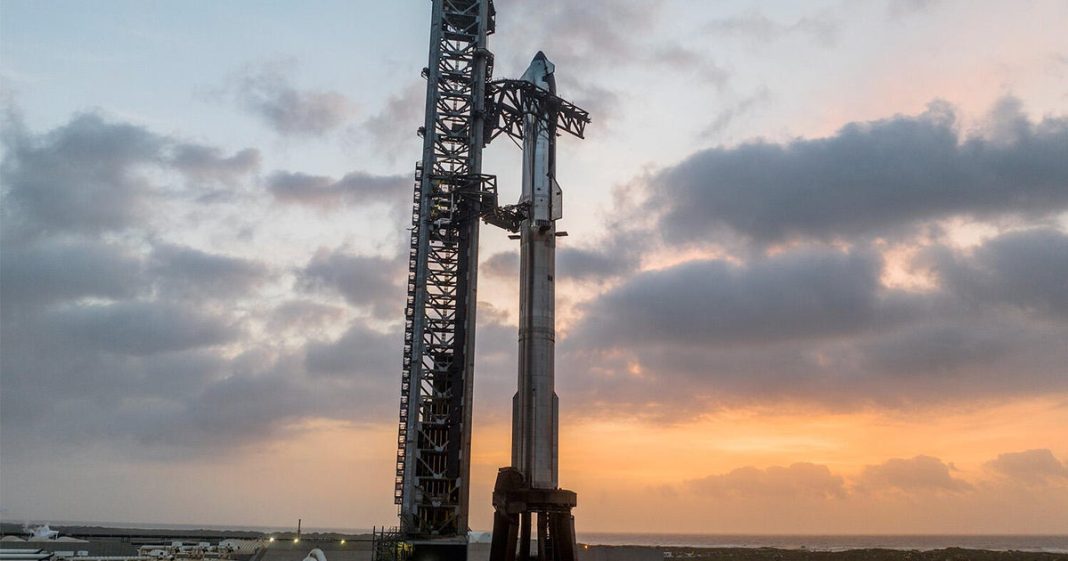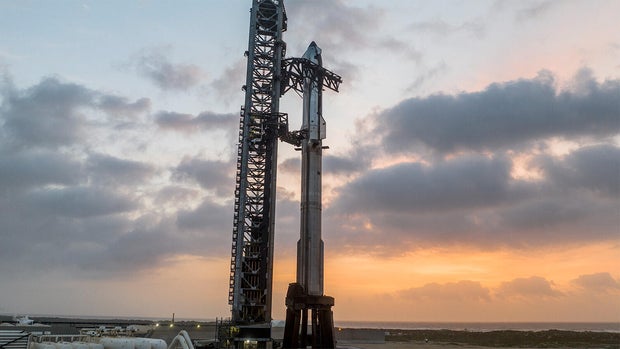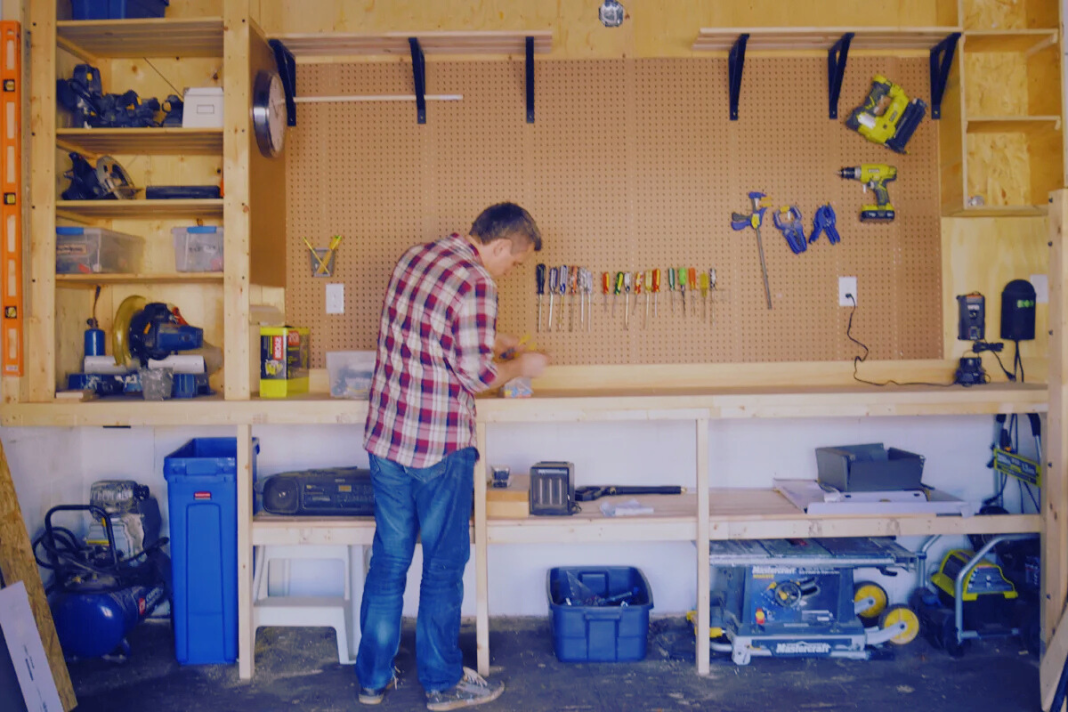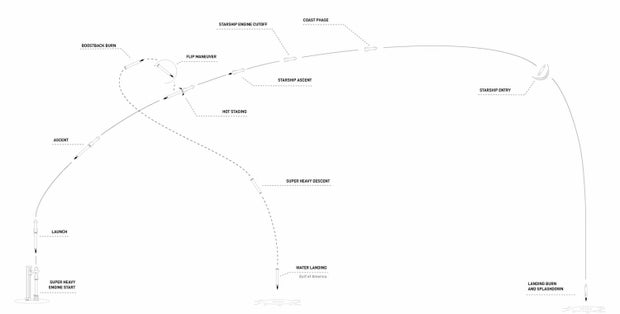
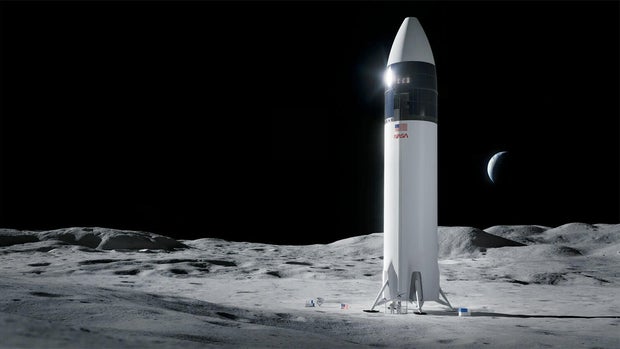
With Federal Aviation Administration approval, SpaceX readied a gargantuan 400-foot-tall Super Heavy-Starship for its 9th test flight Tuesday — a launch featuring multiple upgrades in the wake of spectacular back-to-back upper stage failures during the previous two flights in January and March.
Company founder Elon Musk planned to provide a post-launch update on his long-range plans to “make life multi-planetary,” presumably outlining the role the Super Heavy-Starship will play in eventual flights to Mars. He originally planned to speak before the latest launch but decided, without explanation, to hold it up until after the flight.
The huge rocket’s launching, known as “Integrated Flight Test 9,” was targeted for liftoff at 7:30 p.m. EDT from SpaceX’s sprawling Boca Chica, Texas, manufacturing-and-flight facility, known as Starbase, on the Texas Gulf Coast.
Plans for the latest SpaceX test flight
The mission featured the first use of a previously flown 23-story-tall Super Heavy first stage, which flew itself back to capture by giant mechanical arms on the launch tower during the program’s seventh test flight in January.
For the program’s latest launch, the Super Heavy first stage, powered by 33 methane-fueled Raptor engines generating up to 16 million pounds of thrust, will follow the same flight plan as previous missions, propelling the Starship upper stage out of the thick lower atmosphere on an easterly trajectory toward the Straits of Florida.
Equipped with six Raptors of its own, the 160-foot-long Starship was expected to separate from its booster about two-and-a-half minutes after liftoff, heading for a sub-orbital trajectory carrying it toward a planned vertical splashdown in the Indian Ocean.
The Super Heavy, meanwhile, will use a different method for flipping around for the trip back to the launch site in a bid to save propellants. It also was programmed to fly a much steeper descent than usual to learn more about the stresses it can safely endure.
“The booster will attempt to fly at a higher angle of attack during its descent,” SpaceX said on its website. “By increasing the amount of atmospheric drag on the vehicle, a higher angle of attack can result in a lower descent speed which in turn requires less propellant for the initial landing burn.
“Getting real-world data on how the booster is able to control its flight at this higher angle of attack will contribute to improved performance on future vehicles, including the next generation of Super Heavy.”
As a result of the high-stress tests, the booster will guide itself to splashdown in the Gulf instead of attempting a launch pad capture where critical infrastructure could be damaged in a landing mishap.
The Starship will attempt a repeat of the missions planned for the previous two flights, both of which failed before they could reach their planned trajectories.
Eight dummy Starlink internet satellites will be released to test the deployment system, a single Raptor engine will be reignited to test its start-up capability in space, multiple heat-shield tiles have been removed to “stress test” vulnerable areas and launch pad capture fittings are in place to learn how they stand up to the space environment.
Launch attempt follows two Starship breakups
Tuesday’s planned launching comes on the heels of back-to-back Starship upper stage breakups during the two previous test flights that generated spectacular showers of flaming debris along the flight paths.
Since then, SpaceX engineers carried out extensive testing and implemented multiple upgrades and improvements to minimize the chances for similar failures. The Federal Aviation Administration, which oversaw both failure investigations, gave SpaceX permission to proceed with IFT-9 last week after wrapping up the IFT-8 review.
“The FAA conducted a comprehensive safety review of the SpaceX Starship Flight 8 mishap and determined that the company has satisfactorily addressed the causes of the mishap, and therefore, the Starship vehicle can return to flight,” the agency said in a statement. “The FAA will verify SpaceX implements all corrective actions.”
In both of the previous failures, commercial airline traffic in and around the Straits of Florida was held up pending confirmation falling debris was no longer a threat. For the ninth flight, the length of the Aircraft Hazard Area was expanded from about 1,000 statute miles to around 1,840 miles and SpaceX was required to launch the rocket during non-peak air travel periods.
Plans for the moon and Mars
The Super Heavy-Starship rocket is critical to NASA’s plans to land astronauts on the moon in the next few years and to Musk’s plans to eventually send humans to Mars.
NASA plans to use a variant of the Starship upper stage as a lunar lander in the agency’s Artemis program. NASA wants to use its own rocket and crew capsule to ferry astronauts to lunar orbit where the SpaceX lander will be waiting to carry them down to the surface.
The Trump administration wants to cancel NASA’s Space Launch System rocket and Orion crew capsule, leaving the future of the Artemis program, as it’s currently envisioned, in doubt. For his part, Musk has argued the United States should pass up moon missions, which he called a “distraction,” and instead head directly to Mars.
In any case, the Super Heavy-Starship rocket is expected to play a major role in future deep space exploration, regardless of the target. But multiple successful test flights will be needed to demonstrate the safety and reliability needed for astronauts and passengers heading to the moon, Mars or beyond.
SpaceX made changes after two catastrophic explosions
The last two Starships, launched Jan. 16 and March 6, both ended with unrelated catastrophic explosions as they neared their planned sub-orbital trajectories.
During the January flight, a propellant leak in an unpressurized “attic” above the Raptor engines led to sustained fires that eventually triggered shutdown of all but one of the spacecraft’s engines. Telemetry was lost eight minutes and 20 seconds after launch and moments later, the vehicle broke apart.
“The most probable root cause for the loss of ship was identified as a harmonic response several times stronger in flight than had been seen during testing, which led to increased stress on hardware in the propulsion system,” SpaceX said on its website. “The subsequent propellant leaks exceeded the venting capability of the ship’s attic area and resulted in sustained fires.”
After extensive ground tests, SpaceX made changes to propellant feedlines, and thrust levels and installed additional vents and a new nitrogen purge system in the attic to reduce the potential for fire.
Those fixes appeared to work as expected during the Starship’s eighth test flight in March, but the upper stage again suffered a catastrophic failure. This time around, the Starship suffered a “hardware failure in one of the upper stage Raptor engines that resulted in inadvertent propellant mixing and ignition,” SpaceX said on its website.
To fix the problem, upper stage Raptors now feature a new nitrogen purge system, improvements to the propellant drain system and tighter joints in key areas. SpaceX is also developing an improved Raptor engine that will eliminate several failure modes.
Source link


